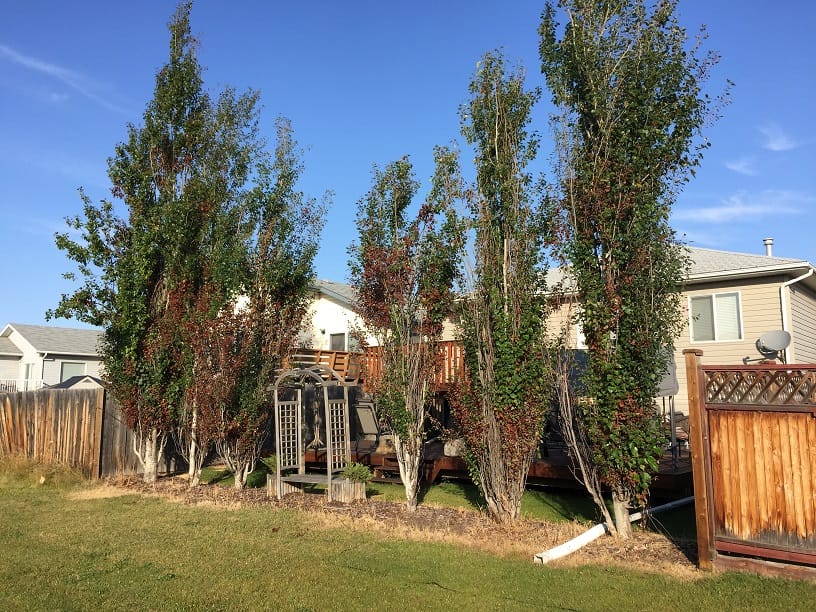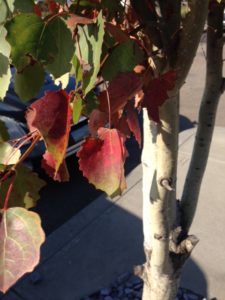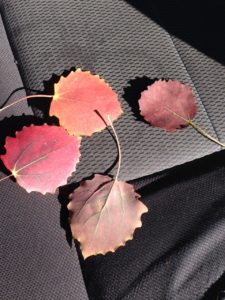Columnar aspen and poplar trees in Alberta have a lot of things attacking them and one of the worst is Bronze Leaf Disease (BLD). Bronze leaf disease is a fungal infection that targets healthy and weak trees alike. This aggressive fungus has no chemical treatments and usually kills its host within three to five years.
The Victim
Bronze Leaf Disease targets Swedish aspens, Tower poplars, and hybrids of the two. These trees are identified by their distinct columnar growth pattern. Both have a large vertical trunk with all branches and stems growing upward. Their foliage usually grows very thick hiding the center stems entirely with only the lowest part of the trunk having visible bark. The bark of each species is light in color ranging from green tinged white to gray. These trees are often planted in numbers as privacy screens or shelter belts, increasing their likelihood of mass infection.
The Problem
Bronze leaf disease is caused by the fungus Apioplagiostoma Populi and begins its infection through the trees’ leaves. After the first winter of infection, the fungus will release its spores during the wetter and warmer conditions in the spring. The wind will carry these spores to other trees where it will settle on their leaves, usually on the lower branches first. The fungus will use the trees vascular system to spread throughout the entire branch and start to girdle it. The fungus will continue to spread around the tree and kill it branch by branch. Infected leaves do not fall off the tree in the fall and will instead shrivel and turn brittle. They will then develop tiny gray fruiting bodies across the leaf surface. Those fruiting bodies will then release spores in the spring to continue the cycle.
The Symptoms
The first symptoms of BLD can be noticed in the spring as infected leaves will start to turn red or brown. The infection will usually start in the lower part of the trees’ canopy and work its way up. BLD infections will cause the colour on the outside of the leaf to change, while the centre and veins remain green. Over time, the green centre will disappear with the entire leaf eventually turning red or brown. Due to this discolouration of the leaves, early infections can be confused with the trees natural new growth colouring. BLD is most obvious in the latter part of summer near the end of July and the beginning of August. The infection will usually affect entire branches at a time, with the whole branch dying at once. As the infection advances, the tree will display dieback where the fungus has already killed off parts of the tree in previous years. The infection will continue to change leaves on infected branches red and any uninfected leaves often will drop earlier in the fall than normal. The infected leaves will remain on the tree as they shrivel up and become brittle. Over winter, these leaves will then develop the tiny gray bumps that spread the disease spores. This process will kill a tree in three to five years with healthier trees being able to survive longer than those that are already struggling.

What Can Be Done
- Monitor your trees. Catching BLD infections early is the best way to save your trees from a slow decline. When infected branches are identified the infection should be removed immediately.
- It is very easy to misidentify BLD because the colouring of new leaves is similar to those infected by bronze leaf. If unsure, have a certified arborist confirm the infection. Professional tree service companies will also have the equipment and knowledge needed to correctly prune for BLD.
- Currently, there are no chemical controls for Bronze Leaf Disease. The best way to handle BLD is to prune it out before the infection can spread throughout the tree. If the tree is already infected to the point that pruning will not be effective, then tree removal is advised. Cuts should be made at least 8 inches back from the infection site which usually works out to be back to the trunk. Cutting tools should be disinfected between cuts and all cuttings should be bagged, sealed, and removed from site. The leaves will still release their spores in the spring even if cut away from the tree. The goal is to prevent the spores from having anywhere to go. Bagged BLD cutting should be buried in a landfill to prevent its spread.
- Maintaining the health of your trees will help them resist infection. Treating other ailments as they arise, pruning for tree health, and fertilizing/watering as needed will help your trees survive early BLD infections.
What Kentucky Blue Grass Can Do
We can maintain the health of your trees with professional assessments, pruning, ailment treatments, fertilizing, and watering. We can identify Bronze Leaf Disease and correctly prune for infection control. If a tree is infected too severely for pruning, we can removed the tree and advise how to prevent infection in nearby trees.



Comments are closed